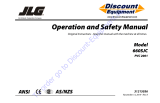
9
Section 1 – About this Mobile Elevating
Work Platform (MEWP)
1.1 Read and heed
Skyjack is continuously improving and expanding
product features on its equipment; therefore,
specications and dimensions are subject to change
without notice.
1.1-1 Mobile Elevating Work Platform
(MEWP) denition
A mobile machine intended for moving persons, tools,
and material to working positions, consisting of a work
platform with controls, an extending structure and a
chassis.
1.1-2 Purpose of equipment
The Skyjack Vertical Mast lifts are designed to move
personnel, tools, and materials to working positions.
1.1-3 Use of equipment
The MEWP is a highly maneuverable, mobile work
station. Work platform elevation and elevated driving
must only be done on a rm, level surface.
1.1-4 Operation manual
The operation manual is an important part of the
MEWP. It is important to always keep a copy of this
manual in the weather-resistant manual storage box of
the MEWP. The manual must be in good condition.
1.1-5 Operator
The operator must read and completely understand
this operation manual, the safety panel label located
on the platform, the limitations, operating procedures,
operator’s responsibility for maintenance and all other
warnings and instructions in this manual and on the
MEWP.
Before you operate the MEWP, make sure you read
and completely understand this information:
1. The full contents of the operation manual,
including the MEWP limitations and the
responsibilities of the operator for the operation,
applicable maintenance and safety instructions.
2. The safety panel label on the platform, the labels
on the MEWP and the attachments.
Compare the labels on the MEWP with the labels in
this manual. Immediately replace any labels that are
damaged or missing.
Only trained and authorized personnel shall be
permitted to operate a MEWP.
The operator must be familiar with the employer’s
work rules and related government regulations.
1.1-6 Service policy and warranty
Skyjack warrants each new product to be free of
defective parts and workmanship for the rst 2 years
or 3000 hours, whichever occurs rst. Any defective
part will be replaced or repaired by your local Skyjack
dealer at no charge for parts or labor. In addition,
all products have a 5 year structural warranty.
Contact the Skyjack Service Department for warranty
statement extensions or exclusions.
1.1-7 Ownership of MEWP
Notify Skyjack of MEWP ownership. If you sell or
transfer the ownership of a MEWP, promptly notify
Skyjack of the new owner’s contact information.
Skyjack needs this information to inform the owner of
any updates or additional activities that are necessary
to keep the machine in proper working condition.
1.1-8 Optional equipment
This MEWP is designed to accept a variety of optional
accessories. Refer to Section 7.1 for a list of the
optional accessories. Operating instructions for these
options are located in Section 5 of this manual.
For components or systems that are not standard,
speak to the Skyjack Service Department. Give the
model and serial number for each applicable MEWP.






















